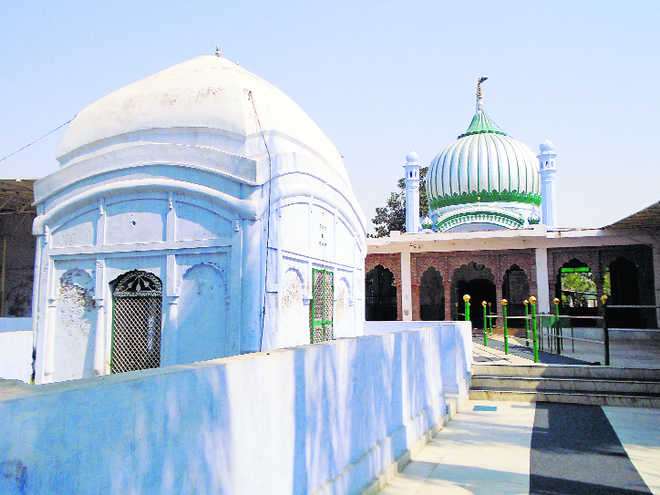Sufi connection of Sadhaura
Virender Singh Dhillon
The Qasba of Sadhaura in Yamunanagar district dates from the times of Mahmud of Ghazna (997-1028 BC), and houses a number of mosques built in medieval era, according to the Archaeological Report of CJ Rodgers (1888-89). The mosques of Tusi and Abd-ul Wahab, Qazion ki Masjid and the tomb of ‘Roza Pir’ are the major mosques, which were constructed in Sadhaura in medieval times. The fort of Sadhaura is now dismantled. It lies on the banks of the Nutki Naddi and in between the mosque of Tusi and Qazion ki Masjid. Pir Shah Qumais was a famous Sufi saint of Sadhaura in the times of Akbar.
Sadhaura became a Sufi centre of the Qadriyyah Qumaisiya subsect of Qadiri silsila in the late 16th century after the death of Pir Shah Qumais in 1584. A fair is held every year at the shrine of Shah Qumais, commonly known as ‘Roza Pir’, which is attended by around one lakh aficionados, mostly Hindus of nearby areas and from outside. Muslims from Punjab, Bihar, Bengal, Hyderabad, Maharashtra, Karnataka, Rajasthan, and Gujarat and even from Pakistan visit the shrine during the ‘Urs’ (festival to mark the death anniversary of Sufi saint) of the Pir. Why is he called ‘Roza Pir’? The word ‘Roza’ is an aberration of the Arabic word, ‘Rawza’ meaning ‘Garden’. The tomb of the saint was called ‘Roza Pir’ as it was surrounded by gardens on the three sides and the Nutki Naddi on the fourth.
Sufis (Islamic saints) in India were always in discord with orthodox ‘Ulemas’ (religious scholars) of Islam. The Sufi movement crystallised into a series of ‘orders’ (silsila, literally ‘chains’), which formed around a charismatic Sufi saint. The concept of ‘Pir-murid’ relationship was the basis for the silsila, which stretched back as a line of transmission all the way to Prophet Muhammad. During medieval times in Haryana, there were three important centres of Qadiri Silsila: Sadhaura, Kaithal, and Panipat. In Sadhaura, Shah Qumais founded Qadriyyah Qumaisiya (a chain of Sufi saints); in Kaithal, Shah Kamal Qadiri founded Qadriyyah Kamaliya; and Panipat also remained an important centre of Qadriyyah Silsila. The principal authority on Qadriyyah Qumaisiya is Pir Muhammad Lahori’s Khuariqat-i Shah Qumais Qadiri — a Persian manuscript available in Azar Collection, Punjab University, Lahore (Pakistan). Abdul Haq Dehlavi’s “Akhbar-ul Akhyar” and Ghulam Sarwar Lahori’s “Khazinat-ul Asfiya” are other Persian documents which throw light on the life and teachings of Shah Qumais.
Shah Qumais was a spiritual descendent of Shaikh Abdul Qadir of Baghdad (the founder of Qadriyyah Silsila in the twelfth century). His father Shah Abul Hayat, contributed a lot to the propagation of Qadiri Silsila in Bengal. Out of the three sons of Shah Abul Hayat, Shah Qumais was the only surviving scion, who married the daughter of Sultan Shah Hussain of Bengal. Like his father he also married in the royal family, but his wife died soon. Shah Qumais spent 20 years in a ‘hujra’ (state of poverty and detachment). He migrated to Sadhaura and the fame of his piety increased day by day. Saiyid Nasrullah, a distinguished ‘alim’ of his age, gave his daughter in marriage to the Sufi. Shah Qumais performed seven pilgrimages and visited some sacred places like Mecca, Medina and Baghdad. Finally, he returned to India and settled at Sadhaura. He spent the closing years of his life in Bengal, and died in 1584. His mortal remains were brought to Sadhaura, which is his burial place. His son Shah Abul Muhammad succeeded him as ‘Sajjadah nashin’ (heir). His Qadriyyah heirs were Saiyid Tazzuddin, Saiyid Shah Bahuvuddin, Saiyid Shah Jalal, Saiyid Shah Dawood, Saiyid Shah Ali Jamalullah, Saiyid Shah Abu Saleah Nasr, Saiyid Shah Abdur Razzaq and present ‘Sajjadah nashin’ is Saiyid Shah Abdul Qayum. Shah Qumais cult is said to have been connected with Bihar, and three large fairs are held in Bihar Sharif, Ludhiana and Sadhaura. Shah Qumais’s disciples propagated Qadriyyah Qumaisiya Silsila in Sambhal, Delhi, Bihar, Ludhiana and Sadhaura. A shrine was constructed by his ‘Sajjadah nashin’ and ‘murids’ at Sadhaura in 1590 and since then an Urs mela takes place on the dargah of Shah Qumais in January every year.
(The writer teaches history at Maharaja Agrasen College, Jagadhri)
Unlock Exclusive Insights with The Tribune Premium
Take your experience further with Premium access.
Thought-provoking Opinions, Expert Analysis, In-depth Insights and other Member Only Benefits
Already a Member? Sign In Now










